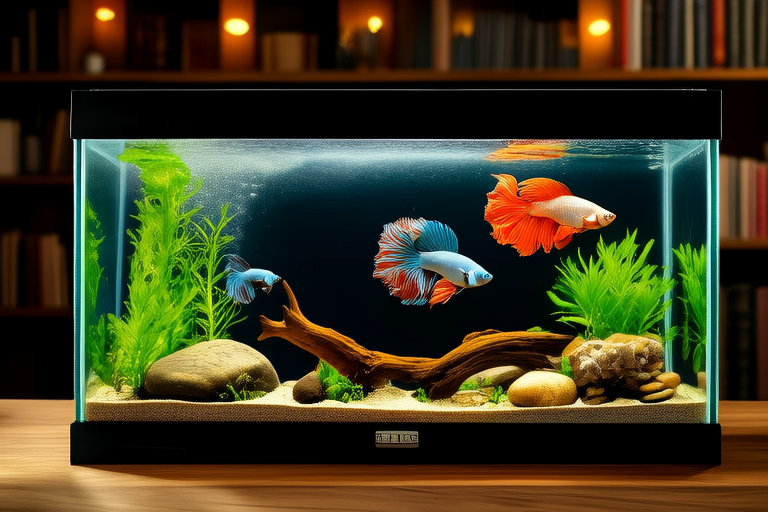The Ultimate Guide to Creating a Thriving Betta Paradise at Home
Welcome to your ultimate guide for creating a thriving Betta paradise! Whether you’re a beginner or an experienced aquarist, this article will walk you through everything you need to know about setting up and maintaining a healthy, vibrant home for your Betta fish. With their flowing fins and bold personalities, Bettas are truly captivating creatures. Let’s dive in and explore how to give them the best life possible!
Setting Up the Perfect Tank
Tank Size: Bigger is Better
One of the most common mistakes beginners make is keeping Bettas in small bowls or vases. While these fish can survive in smaller spaces, they thrive in larger environments. A tank size of at least 5 gallons is recommended for one Betta. This provides enough room for swimming, reduces waste buildup, and makes it easier to maintain stable water conditions.
Filtration: The Lifeline of Your Tank
Bettas prefer calm waters, so choose a gentle filter that won’t create strong currents. Sponge filters or hang-on-back filters with adjustable flow rates work well. Filtration not only keeps the water clean but also promotes beneficial bacteria growth, which helps break down harmful toxins like ammonia.
Heating: Keeping Things Cozy
Bettas are tropical fish, meaning they require warm water to stay healthy. Invest in a reliable aquarium heater to maintain a consistent temperature between 76°F and 82°F (24°C–28°C). Sudden temperature fluctuations can stress your Betta, so use a thermometer to monitor the water regularly.
Water Parameters: The Foundation of Health
Temperature Stability
As mentioned earlier, Bettas thrive in warm water. Avoid placing the tank near windows, heaters, or air conditioners, as these can cause temperature swings. Consistency is key!
pH Levels: Finding the Sweet Spot
Ideal pH levels for Bettas range from 6.5 to 7.5. Test your tap water before setting up the tank, as some areas have naturally hard or soft water. If adjustments are needed, use pH stabilizers sparingly and gradually to avoid shocking your fish.
Ammonia, Nitrite, and Nitrate Levels
Ammonia and nitrite levels should always be zero, while nitrates should remain below 20 ppm. Regular water changes (about 25% weekly) help keep these parameters in check. Cycling your tank before introducing your Betta ensures a safe environment by establishing beneficial bacteria colonies.
Plants and Decorations: Creating a Natural Habitat
Suitable Plants for Bettas
Bettas love lush, planted tanks because they mimic their natural habitat. Live plants like Java Fern, Anubias, and Amazon Sword are excellent choices since they’re easy to care for and provide hiding spots. Floating plants like duckweed or frogbit offer shade and surface cover, which Bettas appreciate.
Decorations That Work
Choose smooth-edged decorations to prevent tearing your Betta’s delicate fins. Driftwood, ceramic caves, and silk plants are great options. Avoid sharp objects or overcrowding, as these can lead to injury or stress.
Avoid Overcrowding
While it’s tempting to fill the tank with lots of decor, remember that Bettas need open space to swim. Strike a balance between aesthetics and functionality to ensure your Betta has room to explore.
Dietary Needs: Feeding Your Betta Right
Variety is Key
Bettas are carnivorous and require a protein-rich diet. High-quality Betta pellets should form the base of their meals, supplemented with frozen or live foods like brine shrimp, bloodworms, and daphnia. Rotate their food to provide variety and prevent nutritional deficiencies.
Portion Control
Overfeeding is a common issue among Betta owners. Feed your Betta once or twice daily, offering only what they can consume within two minutes. Remove uneaten food promptly to avoid polluting the water.
Tank Mates: Can Bettas Share Their Space?
Choosing Compatible Companions
Bettas are territorial and may become aggressive toward other fish, especially those with bright colors or long fins. However, peaceful species like Corydoras catfish, Kuhli Loaches, and certain types of snails can coexist harmoniously if the tank is large enough and properly arranged.
Going Solo
If you’re unsure about adding tank mates, don’t worry—Bettas often do just fine on their own. They’re interactive pets that enjoy human interaction and don’t necessarily need companionship.
Common Health Issues and Prevention Tips
Fin Rot
Fin rot is caused by poor water quality and stress. Symptoms include frayed or discolored fins. To prevent this, maintain pristine water conditions and avoid overcrowding or aggressive tank mates.
Ich (White Spot Disease)
This parasitic infection appears as tiny white spots on the body and fins. Quarantine new fish before introducing them to the main tank, and treat ich promptly with aquarium salt or medication if it occurs.
Bloating and Constipation
Overfeeding can lead to digestive issues. Fast your Betta for a day or two if bloating occurs, then feed them a cooked, shelled pea to aid digestion.
Maintaining a Stress-Free Environment
Why Stress Matters
Stress weakens a Betta’s immune system, making them more susceptible to illness. Ensure their environment is calm, quiet, and free from sudden disturbances. Cover the tank with a lid to prevent jumping accidents.
Routine Care
Establish a regular maintenance routine, including water testing, partial water changes, and cleaning decorations. Consistent care minimizes stress and keeps your Betta happy and healthy.
Actionable Steps for Long-Term Care
- Weekly Water Changes: Replace 25% of the tank water each week using dechlorinated water.
- Monitor Parameters: Test ammonia, nitrite, nitrate, pH, and temperature regularly.
- Observe Behavior: Watch for signs of illness, such as lethargy, loss of appetite, or unusual swimming patterns.
- Feed Appropriately: Stick to a varied diet and avoid overfeeding.
- Keep It Clean: Rinse decorations and vacuum gravel during water changes to remove debris.
Final Thoughts
Creating a thriving Betta paradise takes time, effort, and dedication, but the rewards are immeasurable. By providing the right tank setup, maintaining optimal water conditions, feeding a balanced diet, and ensuring a stress-free environment, you’ll give your Betta the best chance at a long, happy life. Remember, every detail matters when it comes to caring for these beautiful fish. Happy fishkeeping!
